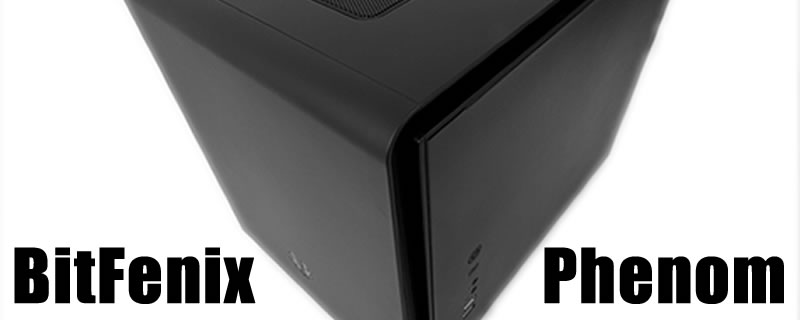BitFenix Phenom M & ITX Review
Conclusion
Those who have taken the time to read the full review will have by now formed their own opinion of the Phenom case. Those who haven’t taken the time, well you’re in luck, because as always we’re going to share our thoughts with you.
If you haven’t guessed already the Phenom is based largely on the Prodigy chassis. Now this is no bad thing as you’ll know from our thoughts on the Prodigy back in May of 2012. Although the Phenom is available in both Micro-ATX and Mini-ITX versions, as the internals of the Mini-ITX version of the Phenom are to all intents and purposes identical to the Prodigy we’ve concentrated our efforts on the Micro-ATX version of the Phenom with all the multi GPU goodness potential that brings.
Turning our attention away from the internals for just for a moment let’s take a while to drink in the exterior. The enclosure is practically a cube, measuring as it does just 250x330x374mm (WxHxD). The front and roof are coated with the oh so naughty to caress SofTouch surface treatment, with even the roof fan grill feeling as if it’s been given a lick of the Naughty brush. It’s a bit of a shame that the sides are merely painted, but then we guess you can have too much of a good thing. Aside from the roof panel and the faux vent strips running along the roof and front edges of the case the lines of the Phenom are largely uninterrupted. Even the front I/O is actually round the side, keeping its 2xUSB3.0, audio jack sockets, Power and reset buttons out of view but within easy reach.
Owing to the larger Motherboard the Phenom M-ATX isn’t quite as cavernous inside as the Mini-ITX version, that said, you will still be able to find a home for up to 5×3.5″ drives and 5×2.5″ drives. CPU coolers up to 160mm can also be accommodated, and if you’re happy to lose the cross brace HDD rack then that height can be upped to 195mm, which should be more than enough for most mortals.
The Prodigy with its Mini-ITX format was oft praised for its prestigious water cooling properties. Changing things round to the M-ATX format of the Phenom has had a bit of an impact, in that you’re no longer going to be able to fit those monster rads in the roof and nothing at all in the front (because that’s where you PSU lives). You are however still going to be able to get any of the 240mm based AIOs such as the H100i, or Seidon 240M up in the roof, or if you want to go custom any rad up to about 35mm thick but that’s about it. The M-ATX format also offers the capability of going dual GPU, by which ever flavour you favour, although at this point we feel compelled to mention that if you want to add a second GPU you’re not going to be able to fit a roof mounted rad, AIO or otherwise. All is not lost on the AIO front though as any of the 120 or 140mm rad based units can be placed back there, so coolers such as the H80i, H60i, H90 and Kraken X40 should be on your shopping list.
So where’s the benefit in going Micro-ATX with the Phenom as opposed to Mini-ITX? Well a lot of it boils down to personal preference, whether you want to fit monster rads or are happy with a nice simple AIO. That of course and the price of Motherboards. You see, pound for pound you do seem to get more for your money with an Micro-ATX board. Sure there are some decent Mini-ITX boards out there, but they have a habit of costing quite a bit more than their Micro-ATX Brethren. Now throw in the inherent ability of the Micro-ATX platform of being able to accept two GPUs and you start to see the appeal. If you need any more convincing, take a look around at the number of people who have modded the Mini-ITX Prodigy to accept the an M-ATX board and you’ll start to get a feeling for the desire in the communities for a version of this chassis that’s able to accept the larger board.
Having talked about the pros and cons of the differing motherboard formats we also need to have a little chat about the cooling options in the Phenom M-ATX. We know you can stick a rad in the roof, and although custom water is on the cards, an AIO solution is certainly the easier option once you’ve factored in finding a home for your pump and res. What isn’t quite so clear whether you go for air or water is how to set up the fans. By default the two 120mm Spectre units situated in the base and the rear of the case are set up to extract giving what is known as a negative pressure set up. We can’t help thinking that being as hot air rises it might have been wiser to either have these on intake or perhaps swap one to the roof position. Putting an air cooler in certainly might make you want to want to switch the base fan to intake or even the rear to intake depending on how you orientate the cooler. Even if you sort things out down below you’re still faced with the GPUs urge to inhale air, and the cooler the better. In M-ATX format with a tower cooler down below its simple enough, it can get it from the roof vent. Stick a rad up there however and it’s going to be fighting it for the same air flow. We’re sure that more time spent with the Phenom would enable us to put these beasts to bed, and we’re certain that there is an optimum set up out there for whatever cooling solution you go with, our point really is that unlike a great many other cases, it’s not immediately obvious what should go where. Still, it’s always nice to have options.
When we reviewed the Prodigy back in May of 2012 we were simply blown away by its price. Since its release we’ve seen the addition of a multitude of colours and options to suite every palate. What has remained however is the low price and the value for money. We’re pleased to say it’s the same with the Phenom, which has started well with a mix of Black and white at launch, and we’re guessing there may well be a similar selection of sensational colours to follow. Price wise the Phenom also kicks much the same bottom as the Prodigy with the Phenom Mini-ITX version costing just under £70 and the Full fat Micro-ATX just a fiver more.  Sure there are cheaper cube cases on the market, but none even come close to the features, value and quality of the Phenom.  To get anywhere close you really have to spend quite a bit more money aiming for such cases as the Carbide Air 540 and Parvum systems range of SFF cases, each of these being well north of £100.
Whether you go for the Micro-ATX or the Mini-ITX version of the Phenom will be down to your personal requirements. In simple terms the Mini-ITX offers greater water cooling support but only single GPU. There are also our concerns about the airflow being limited at the front intake to consider. Opt for the Micro-ATX and you lose a bit of radiator headroom but what you save on the cost of the cheaper Micro-ATX motherboards can be put towards a better GPU. Either way both represent excellent value for money and will look as at home in the lounge as they do on the desk. Decisions decisions…… Â
Thanks to BitFenix for sending the Phenom in for review, you can discuss your thoughts in the OC3D Forums.Â




